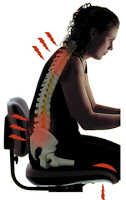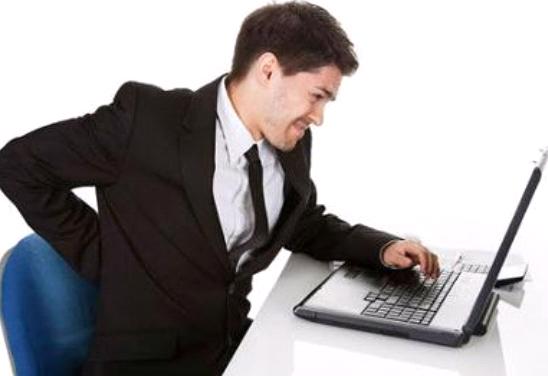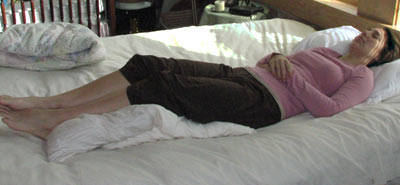Back pain affects up to 8 in 10 people at some point during their lifetime. Back pain is common in part because the spine is central to many of our daily activities, whether strenuous or not. The spine consists of 24 interlocking vertebrae, which are divided into three types: cervical, thoracic, and lumbar. Fibrous ligaments, discs, and muscles connect these bones, allowing for a combination of stability and flexibility to allow us to perform a variety of daily activities.
While we typically think of sitting as a restful activity, prolonged periods of sitting can lead to chronic back pain. Today’s lifestyles often involve significantly more time spent sitting than in previous decades. We all can enjoy the modern luxuries of being able to watch TV, browse the Internet, or order in a precooked meal at the end of a long day of work. However, for many of us, that long day of work involves sitting at a desk, so we go from sitting at work to sitting at home. It has become increasingly recognized that spending many hours planted in a seat is actually detrimental to one’s health. While a brief period of sitting is natural, long periods of sitting typically place the spine and pelvis in an unnatural position for an extended time, leading to low back pain among other issues.
How Does Back Pain From Sitting Develop?
As humans evolved to walk upright on two legs instead of four, the pelvis and spine developed to be able to withstand being up on our “hind” legs. However, by sitting all day, we are not maintaining this upright position that we evolved to be able to maintain. When we sit in a standard chair, the hips and knees are typically kept quite flexed. Over time, this leads the hip flexors, called the ‘iliopsoas muscles,’ to become shortened and contracted. When the hip flexors are tighter due to being shortened, this tilts the pelvis more forward when we stand to walk, changing the normal spine-pelvis relationship and putting abnormal strain on the back.
In addition, it is uncomfortable to sit perfectly upright, as this means sitting directly on the tailbone (coccyx) and the ‘butt bones,’ or ischial tuberosities. Nearly all of us therefore tend to slump when we sit for long stretches, rolling back onto the buttocks and taking the normal sway out of the low back. When the low back is in a straighter/slumped position without its normal sway, this puts significantly more pressure on the discs, which are located towards the front of the spinal column. When one then goes to stand up, it suddenly changes the position of the vertebrae and the discs; this can aggravate disc-related pain. Anyone who has felt a deep throbbing ache in the center of the spine when standing up after sitting or who is unable to stand upright immediately after sitting for awhile has likely experienced this!

What Are The Steps To Lessen Back Pain?
As the issues related to sitting all day at work have become better known, sit-to-stand desks have become much more common in the workplace. However, for many employees, the luxury of a sit-to-stand desk is simply not an option. What can one otherwise do to try to minimize symptoms? Many people ask, “Do I need a super expensive chair?” While there are plenty of ergonomic chairs that cost as much as an entire row of desks, there are simpler solutions that don’t necessarily break the bank!
One easy solution is to raise the height of the chair, so that there is not as much bend in the hips. This likely will require elevating one’s computer monitor/keyboard or other workspace items so that they remain level with the hands and eyes; this can be accomplished with a couple of large books or even a ream of printer paper. By keeping the hip flexors in a more stretched out position, the relationship of the spine and pelvis will be much more normal when one stands to walk. This also makes it naturally more difficult to slump and tilt backwards in a chair. In terms of types of chairs that further accentuate this position, look for a chair with deep cutouts for the legs such as a ‘saddle chair,’ which allows even more room for the hips to remain stretched out.
Another easy solution is to place a lumbar support behind one’s back to match the normal sway of the back. While some chairs have the ability to increase the amount of “lumbar support” of the chair-back, it is easy to place a lumbar support or other small pillow in the small of one’s back if this option is not available. Having a backless chair can alternatively encourage sitting upright, as there is not a chair-back to slump against, though this is not a foolproof method! Exercise balls offer a particularly ‘active’ experience while sitting, forcing one to coordinate the muscles of the core to sit upright, and incorporating subtle shifts in posture that prevent one from becoming stiff in any particular position.
One of the easiest changes is to simply have a reason to get up every hour or so to walk across the office. Instead of sending an email to a colleague, get up to talk to them at their desk. Another option is to drink water regularly, necessitating trips to the water fountain and restroom, with the side benefit of staying hydrated!
Additional Health Problems from Sitting
While there are ways to try and modify sitting such that it is less bothersome for the low back, there are other reasons to try and avoid sitting for long stretches of time. Studies have now demonstrated a link between sitting and increased risk of a variety of medical conditions such as the risk of dying from heart disease, diabetes, and even certain types of cancer. In addition, being otherwise active, such as working out in the morning before sitting all day, does not necessarily protect one against these increased risks! These studies are primarily what are termed “epidemiological studies,” so they do not prove that sitting is the direct cause of these increased risks; it is more likely one piece of the puzzle. However, this burst of new studies over the past 5-10 years have even led to the mantra that “Sitting is the New Smoking.” Regardless of whether one adopts changes for the sake of one’s back or overall health, it’s a good idea to incorporate changes into our daily routine at works such as getting up more frequently to walk across the office or taking the stairs to go out to lunch. One may even find that this clears their head, making one more productive—in any case, who can focus fully on work with an aching, painful back?



